Welcome to Detailed Q2: Our second-ever quarterly report sharing insights from the companies dominating Google search results and what they’re doing to stay ahead of the competition.
SEO is going through the most significant shift I’ve seen in my career thanks to AI, and as someone with sites, clients and students reliant on search traffic, it’s crucial to know what’s working, whose thriving and how Google changes impact different industries.
Q2 – named after the second quarter I’m covering – is my take on how to keep you informed on what the biggest players in this space are doing, as they’re doing it.
When I went live with Detailed Q1 three months ago, I genuinely had no idea whether people would find it interesting. To my surprise, the report got a far better reaction than I could have expected…

If you were one of the people who liked, shared or read the report in any form, Thank You! I truly enjoyed putting it together, and I’ve put my all into this follow-up.
I would **** for this to become my “thing” four times each year, and I’ll add as many exclusives as possible to make it worth your time.
A Quick Note on ‘Outing’ Before I Share 41 Insights from the Last Quarter
Most of what I’m about to share is thanks to tracking updates from Digital Goliaths directly. Companies announce some really interesting things that are typically buried between not-so-interesting updates. I’m simply bringing them to the forefront.
My barometer for what’s fair to cover and what isn’t is whether revealing something would annoy the founder of, or SEO working on, that project. If I think they wouldn’t like it, you won’t see it below.
I’m also not going to reveal anything I believe to be ‘secret’ about a specific business. If there’s something I’m not sure I should share or not, I reach out to the people involved. Here are some responses for insights I wanted to share this quarter:
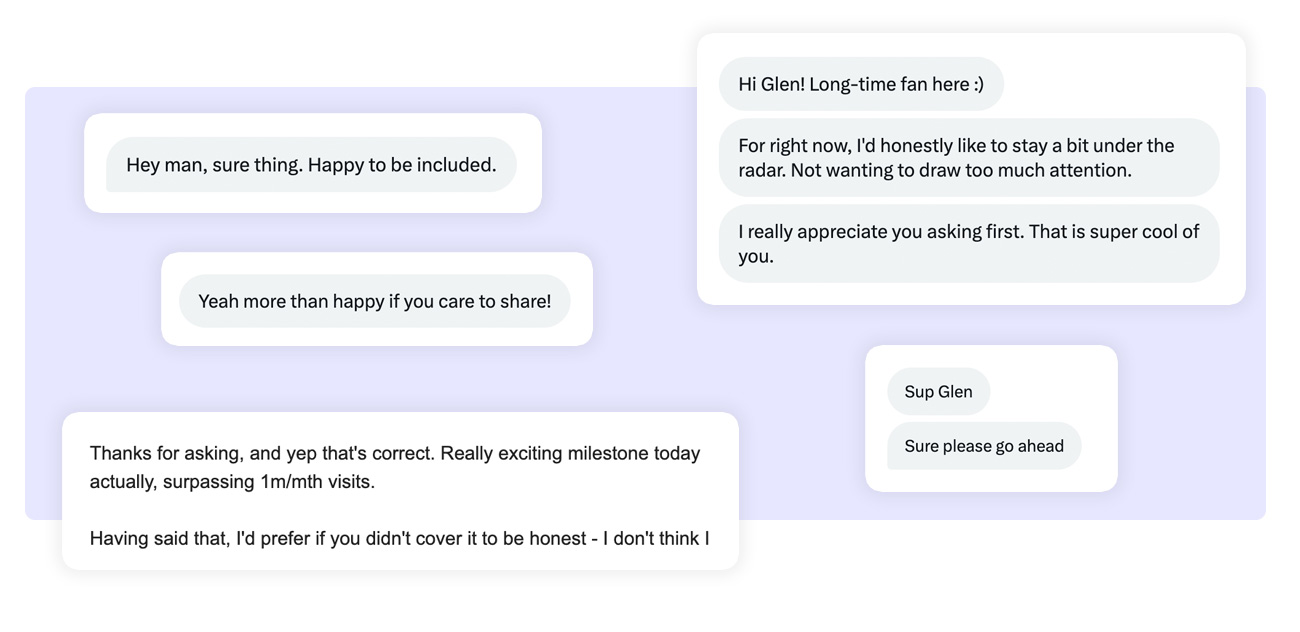
In other words, I’m not going to “out” anybody, but I don’t believe that’s required to share a lot of fascinating insights. Hopefully, you’ll agree.
Before the next quarterly report, I’ll finish creating a page on our editorial standards so I can get straight into the value next time.
Speaking of which…
Digital Brands (****** Advice, Hosting Advice, Card Rates) Grow Traffic & Revenue 50%+; Surprisingly Open About Link Building Efforts
I’m not sure how many people check in on the monthly updates of Digital Brands but I don’t miss a single one.
They’re surprisingly open about what they’re doing each month to grow the rankings of their market-leading brands.
The current sites I track for them are:
- DatingAdvice.com
- CardRates.com
- BadCredit.org
- HostingAdvice.com
- DatingNews.com
Combined, Ahrefs estimates their sites pull in around one million visitors each month from Google. To be respectful, I won’t give the stats for each individually.
If you’re in the hosting review space, where there’s a ton of money to be made as an affiliate, then you’ve undoubtedly seen HostingAdvice in the top rankings over the years.
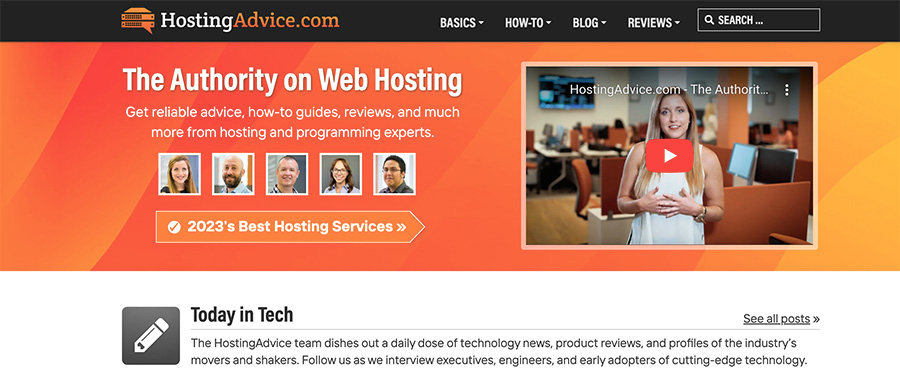
DigitalBrands founder Toby Sembower announced in September that, “We’re on a roll at DB, from increasing traffic and revenue in each month of 2023 (50%+ overall) to adding 7 new amazing team members along the way.”
They’re also surprisingly open about their link-building efforts each month, where they discuss things like scholarship link-building, 3-way link exchanges and more.

Certain aspects of link building can be done legitimately, of course, but brands so reliant on search traffic are typically private about their processes.
I admire how consistent and thorough they are with updates, with multiple team members sharing what they’re working on, and organisation that probably ties back to why they’ve been so successful over the years.
Are Publicly-listed Wag! Now Generating $500,000/m+ From Pet Food Affiliate Commissions?
Q3 of 2023 saw an interesting comment from Wag Group’s Chief Financial Officer, Alec Davidian.
In their most recent earnings call, he said, “Pet food and treats revenue, a new revenue category for this year, was $1.7 million.”
What happened this year for Wag?
They acquired Food Advisor, which promotes food and related products as an affiliate, in a $9M cash deal.
They later launched Cat Food Advisor, which I previously concluded had to have been included in the Food Advisor deal, but had yet to have a website on it in the past.
I noticed they also started adding a lot of food product reviews to their flagship Wag! website, which primarily helps you find local walkers and private pet training.
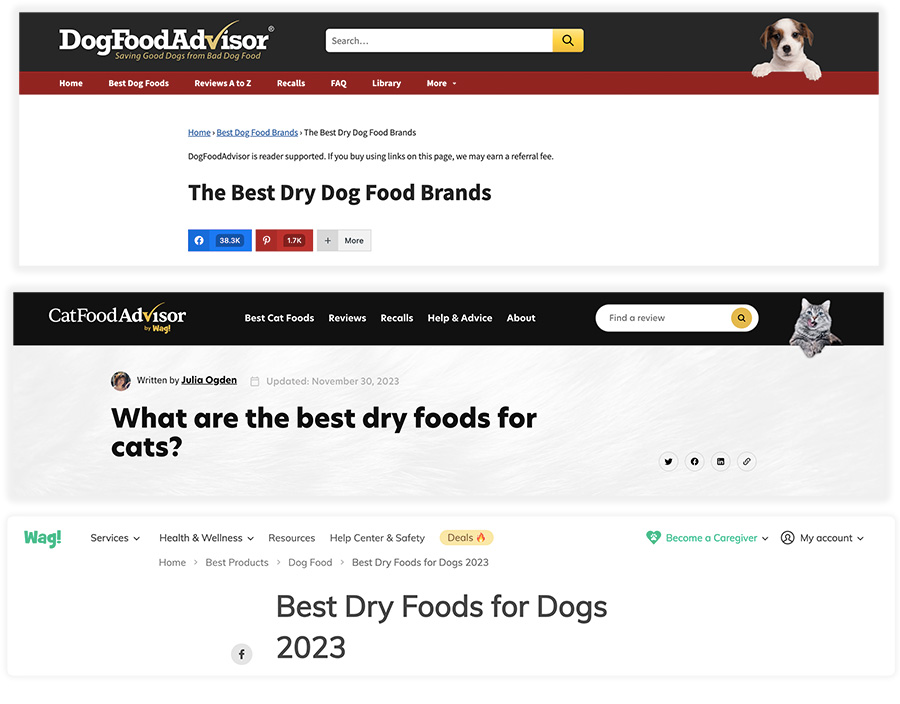
If this all equates to $1.7M in revenue for the quarter then that would imply Wag! Are generating around $560,000/m from affiliate commissions.
This shouldn’t be too surprising to anyone who follows their earnings updates, as in Q1 of 2023 they said, “and new in Q1, $1.4 million of Pet Food & Treats revenue via Food Advisor”, suggesting affiliate commissions were generating ~$460,000/m earlier in the year.
(I couldn’t find any evidence that they sell their own branded pet food in any way. If they do, it’s not on any of their “best food for X” articles, which is the first place you would expect it to be promoted).
There will be some offset in the numbers since they’re also now selling toys through Wag! Store and Maxbone, the eCommerce store they purchased for $20,000 (not a typo).
Still, it’s fair to conclude they’re generating around half a million dollars per month from this category, which I think will surprise a lot of people.
Automotive eCommerce store CarParts.com Have a Plan to Reduce Their Reliance on Google Search (And Generated $2M from Their First Attempt)
CarParts.com has to be the perfect mix of a brandable name which also receives a lot of direct type-in traffic from people expecting such a website to exist.
The brand’s flagship website was launched in 1999, and just a decade later they would go on to employ more than 800 people in the US and the Philippines.

Today, the site generates hundreds of millions of dollars, with Google organic and paid search estimated by Similarweb to bring in around 67% of their website visitors.
It’s this reliance on Google which has seen them focus on launching an app so they can “own” their audience:
I think for us, app is probably one of the most transformational initiative that we worked on over the last couple of years. Historically, the majority of our customers find us on Google. And so we rely heavily on search engine optimization and performance marketing on Google. [..] What we’re trying to do is get that mobile traffic to go from searching on Google to directly on the app.
Later, in the same Q3 2023 earnings call, they revealed that the app has “over 70,000 downloads and $2 million of revenue.”
It’s only a small dent into what they generate through other methods, but it’s certainly a start.
Publicly-listed Nextdoor Announce Using Gen AI to Create 300,000 Pages of Content for SEO
I can’t say I’ve ever used Nextdoor, the hyperlocal social network with apps targeting people in the US and the UK.
As they’re a digital-first brand on the stock market though, I try and keep on top of how well they’re performing.
I was intrigued by their most recent earnings call when they made some comments about SEO, which I don’t recall being typical for them.
Take a look:
And I also did mention that we saw almost 300,000 pages created using Gen AI to put out there from an SEO perspective. That’s a really good way to drive people back to Nextdoor to make sure we keep showing up as being highly relevant. It’s also important because it’s a way to not show all of our data externally rather to effectively give a really performance summary, but to ensure that our proprietary data stays proprietary within the Nextdoor’s vault.
Emphasis my own.
Unfortunately I’m going to let you down here because I can’t figure out exactly where that content has been posted. Ahrefs content charts don’t load on sites of this size.
I checked their engineering blog to see if it revealed any insights and while it covers their use of AI, it’s in reference to sending emails rather than anything SEO-related.
Similarly, their main company blog has discussed Generative AI regarding posts people make on the platform, but that doesn’t sound like what they were referring to.
If anyone knows any specifics, I’ll happily update this section. Either way, seeing a company be so open about putting so much AI-generated content out there is…interesting.
Hearst Take Aim at the New York Times With A New Puzzle Site That’s Already Reached Hundreds of Thousands of Visitors
You might not know it, but games are of huge importance for legacy publishing brands.
The New York Times revealed on a recent earnings call over 10 million people each week play some form of game on their website.
Over one million were paying for a premium games subscription, even before they acquired the hugely popular Wordle.
The UK’s Telegraph Media Group just celebrated the first anniversary of their online puzzles in September.
The same month, The Daily Mail revealed that 90% of their puzzle players have a 30-day playing streak on their website.
Now, the publisher behind brands like Cosmopolitan and Elle, Hearst, is getting in on the action with the launch of Puzzmo.

Puzzmo isn’t fully open for everyone to use yet has already reached hundreds of thousands of visitors if Similarweb estimates are accurate.
They clearly had The New York Times’ success in mind when launching,
“The New York Times, who basically have the preeminent product in this space, doesn’t have a very extensive product,” Gage tells Axios. “If you look at what they’re doing, it’s basically links to games.”
I don’t know much about the puzzle / crossword space online, but Hearst teamed up with a legend in the space, Zach Gage, to create their games.
Once Puzzmo is fully open, I’ll check back in and report the numbers they’re bringing in.
Futhead, Reaching Up to 1 Million Gamers from Search Each Month, Shuts Down
In August of 2023, the popular site for enthusiasts of the football game FIFA, Futhead, was updated to show a message announcing its closure.
It read, “Unfortunately we have had to shut down operations. We’re so appreciative of your contribution and engagement over the years and wish you a bright, FIFA/FC filled future.”
Futhead was one of the sites we tracked for Digital Goliath Fandom (the #1 brand on our list of 16 companies dominating Google) and was pretty popular if third-party estimates are accurate.
Ahrefs estimates the site pulled in around 500,000 monthly visitors from organic search, compared to one million in Semrush.
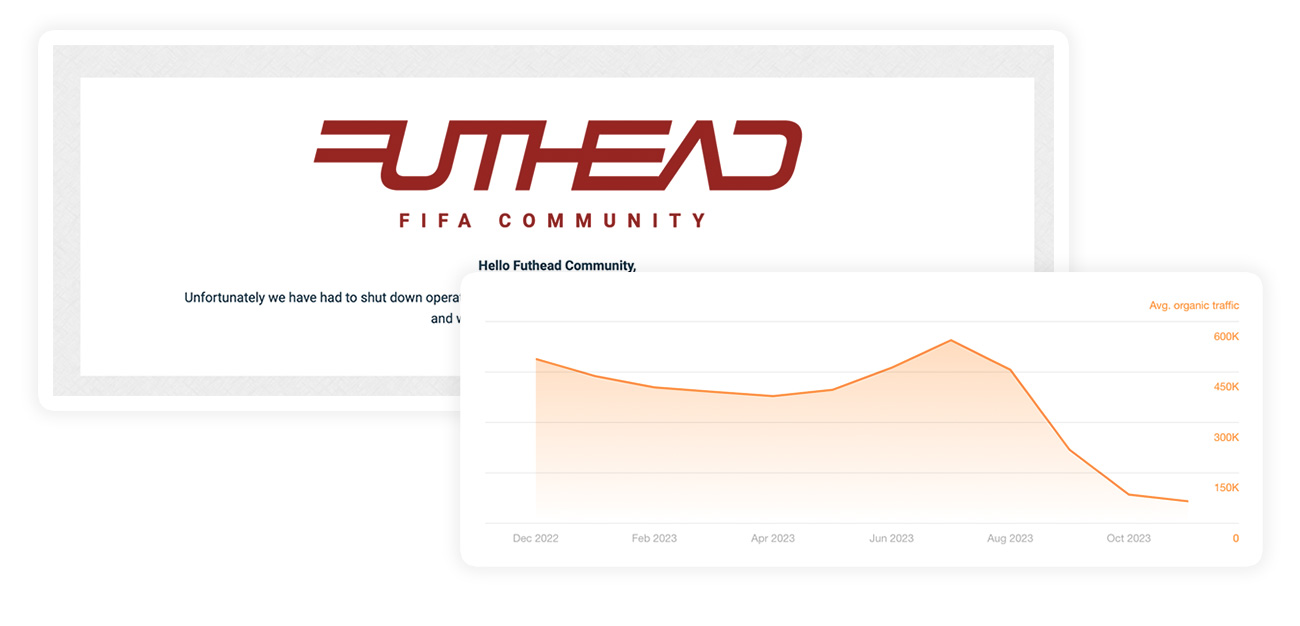
It’s my understanding that Futhead was the first of its kind when it launched back in 2011. The site offered a database of football players for Fifa Ultimate Team and included features such as a squad builder.
In 2013, gaming company Curse acquired it for an impressive $1.1M. The site became part of Fandom in a December 2018 acquisition, which also saw them acquire Gamepedia and D&D Beyond—the latter of which they later sold to Hasbro.
Part of the reason for the site’s closure may be that it was lagging behind similar competitors, such as Futwiz (3M est. monthly visits) and Futbin (28.9M est. monthly visits).
I was obsessed with FIFA when I was a teenager but I haven’t played the game in over a decade now so I don’t know if this applies, but the game recently rebranded to EA Sports FC. I presume ‘FUT’, for Fifa Ultimate Team, will no longer be the correct terminology.
If this was part of their reason for closing, it doesn’t totally make sense as other sites are left with the same problem.
I guess you can do these things when you’re as successful as Fandom, but it’s always a surprise when a well-trafficked site goes offline.
Outside Have Teamed Up With a Denver University to Improve Their Gear Testing, Massively Raising the Bar for “The Best X” Search Results
In my deep dive into the 16 companies dominating Google search results, I revealed that DotdashMeredith, producing content for AllRecipes, Byrdie, and Parents.com, has 250 staff dedicated to reviewing and researching products.
There’s so much money to be made from product affiliate commissions that a number of companies are going all out in their quest to get your final click before purchase.
This month saw the announcement that Outside, who review everything from snowboards to sunglasses, have teamed up with The University of Colorado Denver (CU Denver) to create a private lab for gear testing and product reviews, among other things.
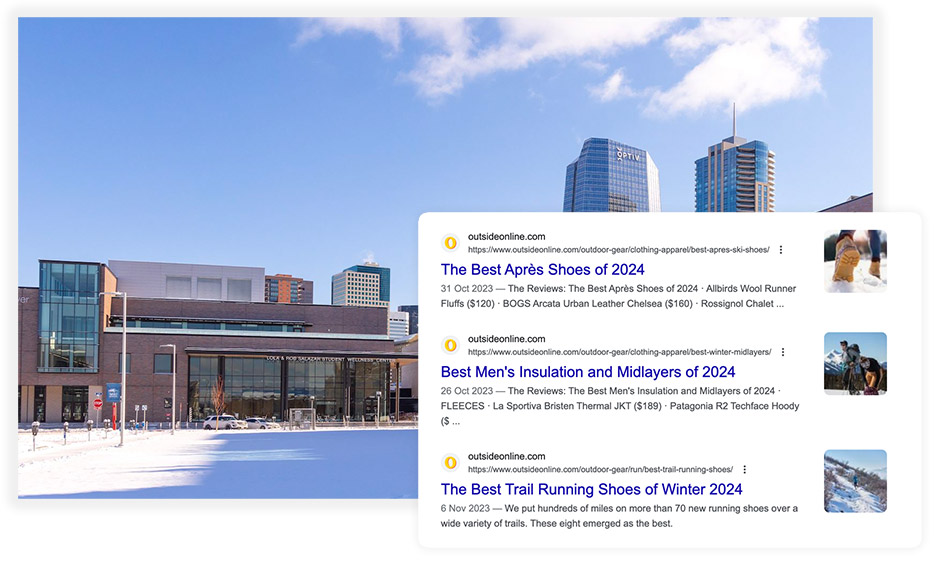
Specifically, they said,
The new lab will enable CU Denver faculty and students, as well as Outside editors and industry partners, to evaluate product performance using top-of-the-line equipment and protocols that are beyond the reach of most brands.
And
When paired with results from Outside’s field testing, the lab data will yield the most comprehensive third-party reviews available to outdoor consumers and Outside’s monthly audience of 80 million active lifestyle enthusiasts.
The announcement didn’t contain specifics like how much money is being invested, but a private testing lab at a university can’t be cheap.
When there’s so much money to be made, the bar for what constitutes quality content in this space will continue to rise.
Chowhound Was So Popular the New York Times Covered Its Closing Last Year. Now It’s Back Under New Ownership
When I shared the news on Twitter in October that Chowhound was back, I’m pretty sure I was the first person on the internet strange enough to notice.
When the “food site for nerds” closed its doors in March of 2022, it was owned by Red Ventures. Huge brands like Food52, The New York Times and Eater covered its closure after 25 years online.
(Red Ventures is behind Cnet, Healthline, Bankrate and dozens of other names you might recognise.)

I can reveal that Chowhound is now under the ownership of Static Media, a digital goliath in their own right.
As you might imagine for a site that picked up so much press for its closing, they picked up a ton of links and press while they were opening, reaching an Ahrefs domain rating of 78.
For context, Detailed has a domain rating of 72, and a link magnet like Wikipedia has a domain rating of 92.
Now we’ll soon see if adding hundreds of articles to an authoritative domain, previously closed for a year, will quickly start ranking well.
I had theorised on Twitter that Static Media had restored hundreds of articles from when the site was owned by Red Ventures, which their former food editor Christine Y Gallary commented on:
None of the articles on the current site are from the old site, as far as I can tell. I used to be a food editor at Chowhound.
I replied showing that there were some articles on the newly-relaunched site with 2019 dates on them:
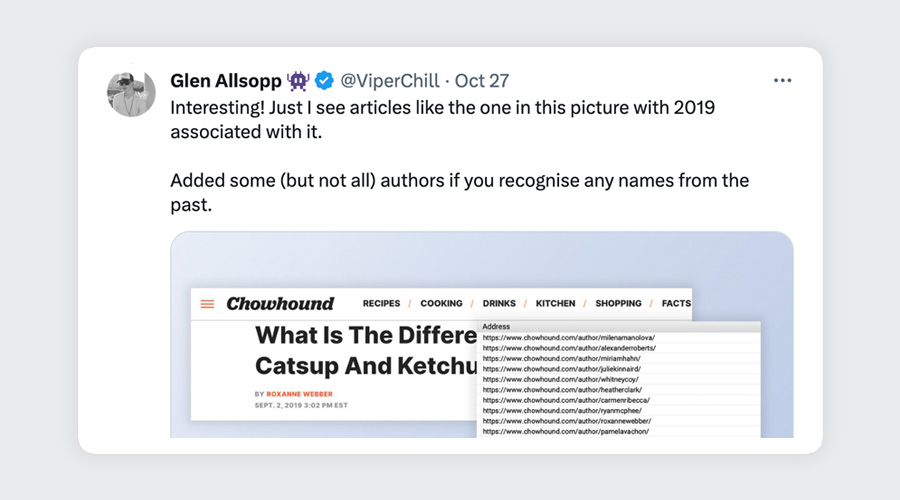
But there’s a new development.
I’m lucky I took that screenshot because that specific article is no longer live on the site. Did I accidentally “catch” them uploading older articles? If so, that wasn’t my intention (and I don’t think it’s a big deal).
Either way, I thought the content would have seen better rankings by now, but that’s what makes SEO fascinating to me. You can never accurately predict how Google will react to a site.
I’ll follow up on this one next quarter.
What do GQ, Vogue and The Verge Have in Common? Our Research Shows They’re All Blocking Google-Extended
In September, Google introduced Google-Extended as a way to block their projects Bard and Vertex AI from using your content to improve their offering.
On the 8th of October I checked 3,078 sites in our database to see how many of them were blocking Google-Extended via their robots.txt file, less than two weeks after it was announced. Eighty-nine sites had quickly jumped on board.
I reran the numbers on November 19th and found the number was now up to 252 sites—a 180% increase.
Danny Goodwin of Search Engine Land covered our research.
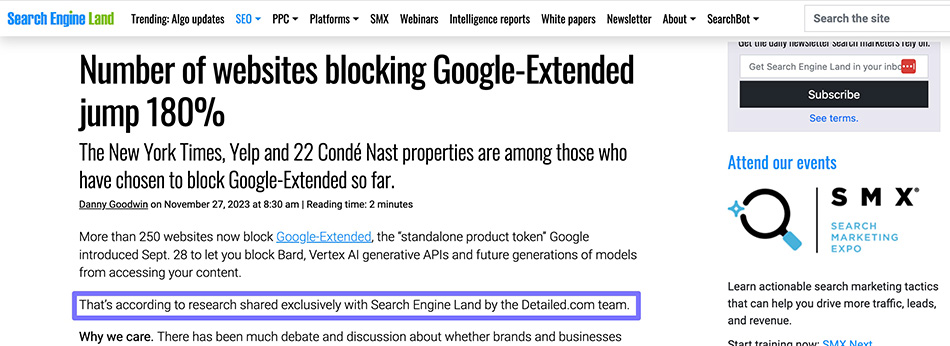
Current sites already blocking it include The New York Times, Yelp, PCMag, GQ, Vogue, Wired and many more names you would recognise.
With Just 11 Pages of Content, OurBabyAI Sees $170 Day Thanks to Search Traffic
Yifan Goh shared on Twitter recently that OurBabyAI had its best day ever, generating ten sales of a $17 product.
He credits organic search traffic for the sales.
As the name suggests, his site lets you combine photos of yourself and your partner to see what your future child might look like.
As I write this, the site boasts 5,500+ customers who have generated over 44,000 photos. Yifan also shared that the site now generates more than $1,000 per month and that organic search traffic was responsible for his record day.
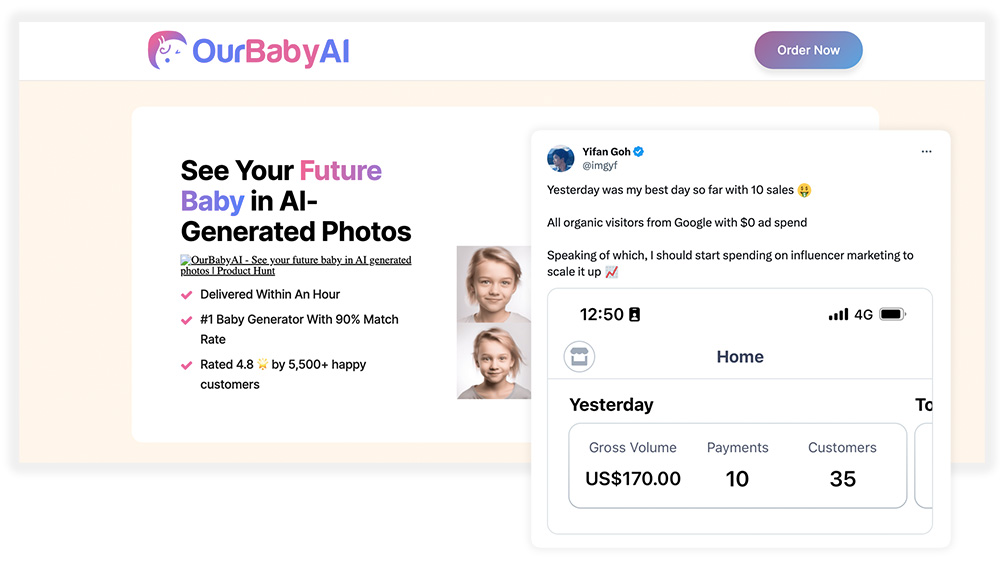
There are a few reasons I wanted to share this example, but the main one is that it’s a great example of how there are always new niche opportunities to generate revenue from search traffic.
Sure, apps have been around for years to give you an idea of what your future children might look like, but the AI spin is pretty new.
Note: As Yifan didn’t connect his tweet to the site generating revenue, I asked permission before covering it here.
Irish Entrepreneur Behind LovinDubai Turns Down $12M Offer for Media Company Generating $1M+
Augustus Media, behind brands such as LovinDubai and LovinSaudi, is one of the more unique media companies I follow.
Augustus was founded by Irishman Richard Fitzgerald in September of 2015, after moving to the Middle East three years earlier.
His sites cover local-focused stories on business news, events and where to shop in the region.
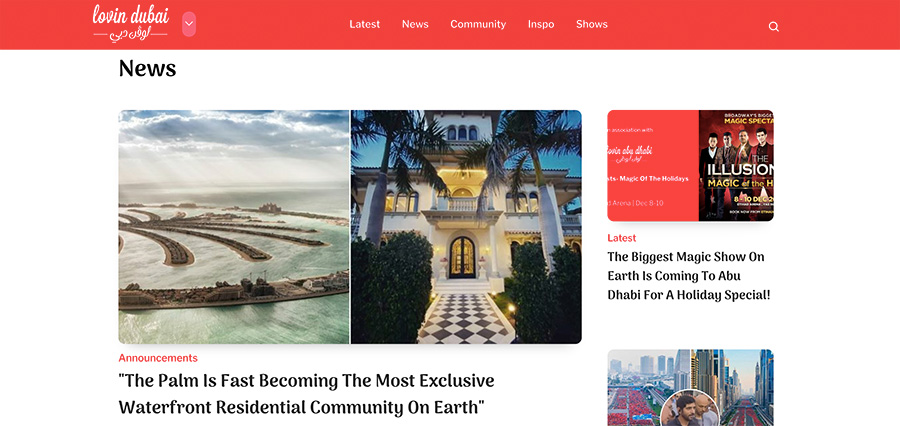
Lovin.co is the primary domain they use, with content for different locations published on subfolders such as /dubai/ and /bahrain/.
In September, Richard tweeted a company-wide email he sent, which started, “Hi all. Today we turned down an offer of $12M for the business from a rival media company.”
Later, he added, “After 8 years of building it might have been tempted [sic] to cash out. But, I’m not in this to get rich.”
There’s more to the business than just producing news stories – they also own a streaming service, Smashi – but the angles he takes with locally focused content has clearly been a smart play.
This UK-Focused Personal Finance Site Has Grown to 2,000 Daily Clicks from Google In Its First Year
I always like seeing people start new sites in crowded industries and tackle them in a smart way: Be super personal, niche down on a specific topic you genuinely care about, produce content in multiple formats (text, audio, video) and perhaps most importantly, stay consistent.
That’s precisely what Sammie Ellard-King has done with his UK-focused personal finance site, Up the Gains.
Sammie revealed on Twitter he’s taken the site from 0-80,000 monthly sessions in just 12 months, sharing this Google Search Console screenshot to go with it:
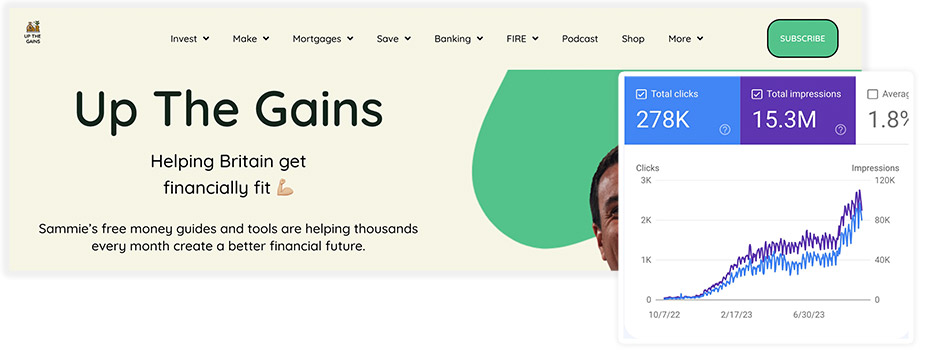
I’ve been so impressed with Sammie that Detailed became the first sponsor of his marketing-focused podcast with Jamie I.F, Click Wars.
While search traffic will always be a great acquisition channel in this industry, huge followings are being built on podcasts, newsletters and social media platforms in the space.
I recently revealed on Twitter that MoneySavingExpert, another UK-focused finance site, has over 8.8 million newsletter subscribers.
GRV Media Surpasses 100M Monthly Pageviews; Launch So Many Sites It’s Hard to Keep Up
In Detailed Q1, I talked about how sports media brand GRV Media keeps breaking records with its network of football (soccer) sites.
Since then they’ve announced passing 100 million monthly pageviews from almost 25 million unique visitors. They also revealed they’ve surpassed 5 million page likes for their brands on Facebook.
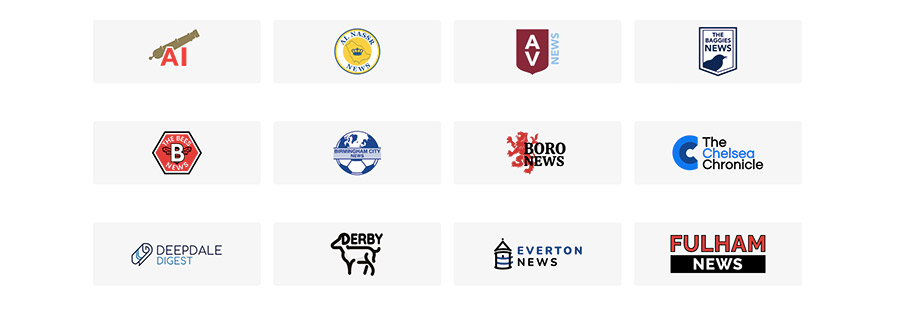
Some of their most popular sites include:
In the last quarter they’ve entered a new niche – American football – with sites dedicated to covering The Kansas City Chiefs and the Dallas Cowboys.
They’re also creating content targeting football fans in Brazil.
When I started following them it was easy to keep up with what they were doing, but now they seem to launch new sites every few weeks.
I know a little about who is behind the network but I’ll let them do the reveal if they ever want to. I’m happy to just enjoy following their journey.
The Independent’s Product Review Section Grows Traffic by 18% (Next Stop: Going Global).
IndyBest, the product review section of the UK’s The Independent news website, grew traffic by 291,000 visitors in the middle of the year—an 18.1% increase.
These numbers reference July, but we’re only revealed on the 31st of August. According to Ahrefs estimates, search traffic has dipped to that section of their website, but it’s still reaching around 1.7 million monthly visitors from search.
As I revealed in Detailed Q1, it appears they get their hands on many of the products they review, but I’m not convinced that’s the case for all of them.
The IndyBest section of their website helped The Independent grow eCommerce revenue by 44% in 2022, and it’s clearly something they’re trying to improve on this year.
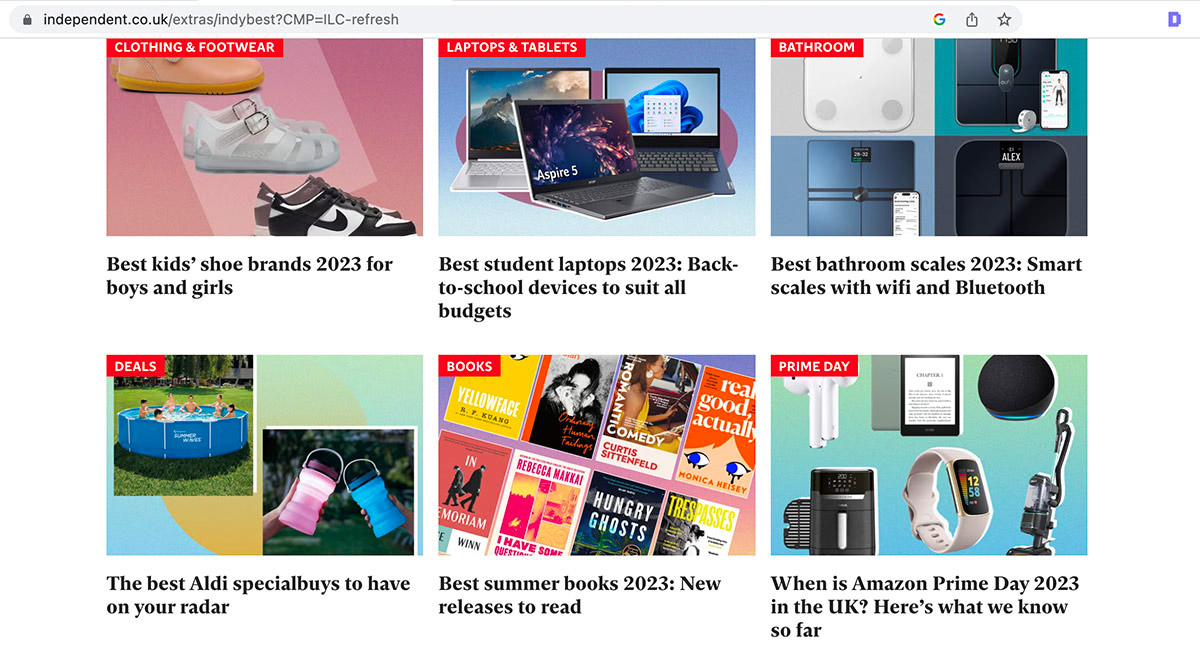
In a September 2023 interview with Press Gazette, CEO Christian Broughton said that the aim for the Independent now is to take things to the next level.
“Let’s grow this thing,” Broughton added. “Let’s take it global. People sometimes describe The Independent as the sleeping giant of media,” including his own colleagues. “It can’t be asleep anymore. It’s really got to grow now.”
I’ll be reporting on it here if they can make that happen.
Reach Plc Are Driving Millions of Pageviews Each Month to Their News Content via…WhatsApp Groups.
The last time I added up the numbers in Semrush, Google send an estimated 125M visitors each month to Reach Plc’s network of UK-focused news sites.
I previously covered that they’re taking their popular UK news brands like The Mirror and The Express stateside and already seeing success in the US.

This month, a surprising report revealed that Reach Plc is now driving millions of pageviews via the popular Meta-owned messaging app, WhatsApp.
The report detailed how Reach have 80 WhatsApp communities with around 100,000 subscribers to them in total. (Communities are limited to 2,000 members each, which helps to explain why they have so many.)
Another fascinating insight is that the open rate on their updates is “something like 90%”.
I share different angles in these reports, hoping that someone reading this sees an opportunity for what they’re working on. The traffic potential here is incredible.
Medium Large Media Just Revealed For the First Time How Much Traffic Their Sports Sites Get
Until a few weeks ago, the sports media brand Medium Large Media had the simplest homepage design in existence.
I wish I had taken a screenshot (The Internet Archive didn’t pick it up) but it was nothing more than a list of links to their properties, like someone had uploaded a .txt file as their homepage.
Thanks to our recent research on who is dominating 250,000 search results (covered in the following insight) I found myself back on their homepage, noticing it had been completely redesigned to show off their brands in style.

Even more interesting for someone like me, they now reveal how much traffic their network of sites is picking up.
Specifically, they’re receiving:
- 2.1M monthly unique visitors
- 3.1 pages per visit
- 10M+ monthly pageviews
It should be no surprise how much traffic sports content can pick up, but I **** seeing niche media brands doing well.
When a Content-Site Ranks First in Google, 86.1% of the Time It’s Owned by a Digital Goliath
If this isn’t your first visit to Detailed then you’ll know I’m hyper-curious about the business success of companies dominating search results via multi-site networks. That’s exactly how this quarterly report came to be.
In September I performed our most extensive analysis of search results yet, looking at 250,000 keyphrases where content-focused sites were more likely to rank.
Even as someone reporting on this topic for years, I was surprised by the results: When a content-focused site ranked first across 186,444 Google search results, 86.1% of the time it was owned by a large media brand. A “digital goliath”.
The top ten content-focused sites overall were:
 Byrdie (Dotdash Meredith)
Byrdie (Dotdash Meredith) Good Housekeeping (Hearst)
Good Housekeeping (Hearst) ESPN (The Walt Disney Company / Hearst)
ESPN (The Walt Disney Company / Hearst) Nerdwallet (Nerdwallet)
Nerdwallet (Nerdwallet) WebMD (Internet Brands)
WebMD (Internet Brands) Medical News Today (Red Ventures)
Medical News Today (Red Ventures) People (Dotdash Meredith)
People (Dotdash Meredith) The New York Times (The New York Times Company)
The New York Times (The New York Times Company) Forbes.com (Integrated Whale Media)
Forbes.com (Integrated Whale Media) Healthline.com (Red Ventures)
Healthline.com (Red Ventures)
If you want to see a (mostly) logical explanation for why these brands are doing so well, I recommend reading the full report. It’s completely free and we put weeks of work into getting those numbers.
The Trend Continues as Four More Media Brands Move Away from Their .co.uk Domains
In our first quarterly report I covered how several media brands have redirected their sites away from their previous .co.uk domain extensions.
One example I gave was Bauer Media Group’s MotherandBaby.co.uk, estimated to receive around 1.1M monthly visitors from search before being redirected to a .com variant of the same name.
Now, we have even more examples to share. I’ve put them in a table to try and make it easier to follow along.
| Previous URL | New URL | Brand | Documented |
| ITPro.co.uk | ITPro.com | Future | Q1 |
| MotherandBaby.co.uk | MotherandBaby.com | Bauer Media Group | Q1 |
| AmateurPhotographer.co.uk | AmateurPhotographer.com | Kelsey Media | Q1 |
| ThePoke.co.uk | ThePoke.com | Digitalbox | Q2 |
| TheWeek.co.uk | TheWeek.com | Future | Q2 |
| GAMINGBible.co.uk | GAMINGBible.com | LADbible Group | Q2 |
| MensFitness.co.uk | MensFitnessToday.com | Kelsey Media | Q2 |
Interestingly, both Future and Kelsey Media have now moved multiple sites away from a .co.uk extension.
I don’t **** the new Men’s Fitness domain but I guess the .com was taken and they’re pretty set on expanding their reach.
These are all redirects I happen to notice myself, rather than them being announced, but there was one exception with Digitalbox who explained their move:
Digitalbox acquired the dotcom domain on acquisition and has now switched it to this domain. This helps provide a clearer opportunity to explore expansion into territories beyond the UK.
This makes logical sense, and it’s just cool to be tracking it in “real-time”.
Monitoring the Site Redirects of Digital Goliaths: Big Brands Still Make a Lot of Big Moves
There are many reasons a company might employ a full-site redirect, and not all of them have to do with SEO.
When SEO is top of mind however, a few reasons include:
- A site is no longer ranking well or may have penalties assigned to it
- You want to combine multiple sites into one to make content creation & other operations easier
- You hope links pointing to the original domain will help the site you’re redirecting it to
The latter is definitely the most common.
With that said, here are some of the most prominent redirects I noticed over the past quarter.
In February of 2022, Digital Goliath Valnet acquired gardening site Backyard Boss as part of a multi-site acquisition.

As far as I can tell, they redirected the site brand to a .com domain for around the entire month of October ’23, then redirected it back to its original .net extension. I don’t think I’ve ever seen this before.
I have to assume they either weren’t happy with what they were seeing analytics-wise, weren’t ready for the move, or just decided not to do it.
IAC’s DotdashMeredith took down their cooking site, CookingLight, and redirected it to another brand of theirs, Eatingwell.
At its peak in 2023, CookingLight was pulling in upwards of 800,000 search visitors per month, according to Ahrefs.
Popular gaming brand Dexerto took down their MyStats.gg site and redirected it to the Call of Duty subfolder on their main site.
EpicGardening founder Kevin Espiritu and his team redirected the site they had previously acquired, AllAboutGardening.
The site was a powerhouse in the gardening space, reaching ¾ million monthly visitors from search each month.
Note: I asked Kevin for permission to share before discussing this, which he was happy to give. I won’t share how the redirect has impacted search traffic for EpicGardening, but your favourite SEO tool will.
Shopify took down an amazing domain name, Handshake.com, and redirected it to a blog post on wholesale suppliers.
NBC closed down GolfChannel.com – reaching over 1M visitors each month from search – and redirected it to https://www.nbcsports.com/golf.
ReedPop closed the cosplay site Cosplaycentral and redirected it to a category page on their other site, Popverse.
SEOs at Outside had a busy quarter, redirecting climbing site RockandIce to another incredible domain they own, Climbing.com.
They also redirected mountain bike resource BetaMTB and running brand Podium Runner.
As a side note, I’m unsure how to style these redirects to make them easy to follow. Should they be in a table? Should I keep bolding the first few words of each example like in the above?
Brand New Tech News Site 404 Media Has Quickly Grown to Reach Millions of Monthly Visitors
It’s no secret that there’s a lot of interest in tech news, but it may be a surprise that a brand-new site covering the space can quickly reach millions of monthly visitors.
That happened recently when former Vice journalists started their publication 404Media (with a .co).
As someone who appreciates websites not following the typical design templates, I respect how much care they’ve put into the aesthetics:

According to Similarweb, around 80% of their 3.5 million monthly visits are split evenly from direct and social media traffic.
Currently, search only accounts for ~7% of visitors, with Ahrefs showing their hundreds of articles aren’t gaining much traction in Google. That’s pretty standard for a new site though.
I don’t have any private insights on how they’ve grown so fast, but having your launch profiled by the New York Times certainly can’t hurt.
If anything, it’s just nice to see another reminder that it’s still possible to grow new brands quickly.
337 of the 522 Content Sites We Track in Similarweb Saw Traffic Decline in the Past Four Months
Outside of our private ~3,000-site database we use to track what’s going on with the biggest brands on the internet, we also separately track the top content sites on Similarweb.
Similarweb estimates will never be perfect, but similar sites in related niches should be relatively comparable.
Of the 522 content-first sites we track in Similarweb – both independent and owned by media companies – 177 saw traffic increase, while 337 saw traffic decrease.
Examples of the kind of content-first sites I track include Space.com, Parade.com, and RunnersWorld.

I’m comparing Similarweb estimates from August and November, each showing data from the prior month. In future, I’ll reduce this comparison to three months instead of four.
Eight websites showed the same traffic estimates four months later.
The median decrease for those that lost traffic was an 800,000 visit loss. This means half lost more than 800,000 monthly visits, and half lost fewer.
On average, they saw visits decline by 25.8%.
For those that gained traffic, the median increase was 502,000 monthly visits.
On average, they saw visits increase by 30.4%.
I didn’t notice any obvious trends as to why some sites gained and others lost. There were sites in almost every niche on both sides of the fence.
That said, sites that saw huge increases have logical explanations, such as they’re focused on covering rugby and cricket, which have had substantial sporting events around them recently.
My hope is that this data will become a lot more valuable when I’m able to compare it year-over-year so we can take trends and seasonality into account.
If you’ve seen traffic decrease over the last few months, then know that judging by third-party estimates, you’re far from alone.
F-At Digital’s Cycling Websites Are Growing Their Reach, Surpass 3M Monthly Unique Visitors
F-At Digital, presumably named after founders Tony Farrelly and Dave Atkinson, is an independent media brand behind three cycling-focused sites: Road.cc, Off-Road.cc and eBikeTips.
(Technically, their other sites are subdomains on Road.cc domains, but they treat them like separate brands).

They recently updated the stats on their homepage to show they’re now reaching 3.2 million monthly visitors and generating 6.4M monthly pageviews.
They also mention a “community” reach of 10.4 million people monthly. I presume community in this sense means their following on social media.
Road.CC is pretty unique in the space, styled more like a newspaper website than the typical “niche site” look we’ve come to expect.
Their eBikes domain looks more like you would expect.
It’s great to see niche-focused site owners doing so well. Long may it continue.
Two Other Large Media Brands (One a Public Company) Just Quietly Updated Their Traffic Numbers As Well
Recurrent Ventures, behind sites such as Popular Science and Field & Stream, increased their monthly traffic stats from 65M to 72M monthly visitors.
They also claim to have over five million email subscribers and 43 million social followers.
Changes were less positive for publicly-listed Gfinity, which reduced its monthly user stats from 16 million to 10 million.
They also reduced their pageview stats from 31 million to 18 million. It may be that the original figures hadn’t been changed in a long time, but the latest numbers were added recently.
The owner of several gaming-focused sites has seen their stock value drop 87% year to ****.
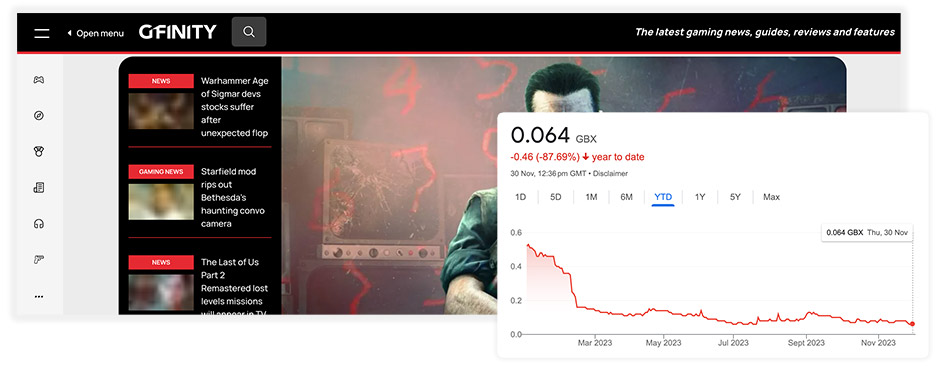
I currently track 10 sites for them, which includes GfinityEsports.com, RealSport and EpicStream.
It’s against our editorial standards to focus on traffic drops unless a site is open about them, which is the case here.
Jim Campbell Grows the Search Traffic Value of Honeymoons.com 4X in Four Months
Search traffic value is not something I’ve ever reported on before but that’s the metric the site’s owner used when discussing his success so I’ll be respectful and stick to that.
(Organic search traffic has followed suit, and I think the chart for that is far more impressive).
In a LinkedIn post, Jim shared what he did in the following months following his Honeymoons.com acquisition.

Specifically, he:
- Improved the speed of the site using Google PageSpeed Insights and Nitropack
- Had editors increase the helpfulness of hundreds of articles, starting with the highest-value pages
- Improved areas of social proof to help give even more trust and credibility to the premium domain
Jim was also on the Niche Pursuits podcast recently, where hosts Spencer and Jared had kindly mentioned me in a few recent episodes, to share more of his story.
Wired Are Launching A Politics Section, Ready For Insane Election Traffic Potential Next Year
WIRED, known primarily for its technology and science news coverage, is about to launch a new politics vertical in preparation for the 2024 US elections.
News sites typically **** election year as the amount of traffic up for grabs is immense. For this reason, 2024 will likely be the best traffic year ever for many of them.
In other words, it makes total sense that WIRED would be getting in on the action, though they do sound like they’ll be linking the coverage to what they’re known for:
From the implications of generative AI to the inevitability of hacks, intrusions, and online manipulation, there is much vital ground for WIRED to cover, and to own, where technology and politics collide.
When owner Condé Nast shared the news on November 3rd, they said the new vertical would appear on WIRED’s website “in the coming weeks”, so we must be close by now.
Intuits TurboTax See Local “Near Me” Searches As Their Next Big Marketing Opportunity
If you’re unfamiliar with the business, TurboTax develops software for preparing tax returns for American citizens.
Millions use their online, app and desktop software to help assist in every step of the process.
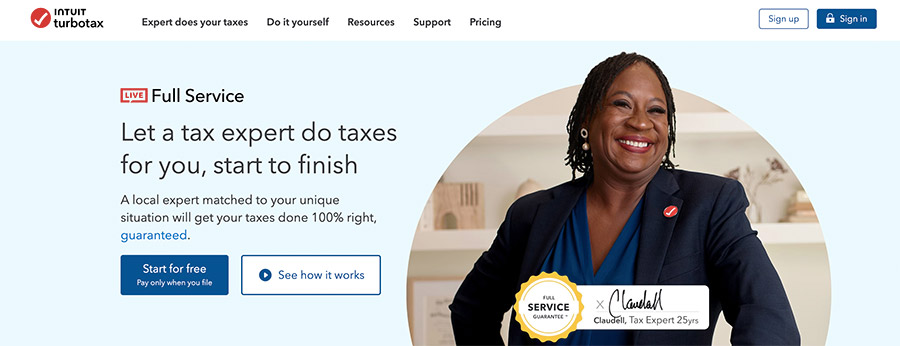
In their Q3 earnings call they made interesting comments about where they feel they can grow the business going forward.
We’re within a 10-mile drive for over 80% of the U.S. and Canadian tax paying and taxpayers, which means we’re more local than anybody. And what that means is we’ll be able to actually open up new channels for marketing like Google Near Me searches, Google Maps, things like Yelp, where we’ll show up as a local provider, because we have local experts in virtually every market across the country and the country is including Canada.
We actually have a data that we look at within our own search parameters right, where customers are looking for TurboTax Near Me, and it’s not an insignificant number. And so we believe that’s just a massive acquisition opportunity for us right. To be able to say, we’re right there, we’re next to you.
In fact about 12 million customers every [sic] are searching for a new assisted provider. And almost half of them actually do Near Me searches and they are looking for someone close by, right? So that’s an acquisition opportunity.
Please note that the emphasis was my own, and I skipped part of the discussions which weren’t as relevant.
Local SEO is not something I assist clients with – I don’t think it’s wise to try and specialise in everything – but I still thought these comments were fascinating. I try to include insights in these reports for people focused on all areas of search traffic acquisition.
If they make any follow-up comments on how their plans are going, I’ll include them in the next quarterly update.
We’re Currently Tracking 289 Media Brands. For Those That Share Revenue Numbers, Here Are the 10 Biggest
With the introduction of ChatGPT which spurned integrations with Bing and responses from Google, how AI impacts people publishing content online (particularly through search traffic) is a huge discussion point in our industry.
With clients, students and my own sites reliant on SEO, I want to know how others are being impacted by developments here.
For that reason I currently track the revenue reports of dozens of the biggest media brands.
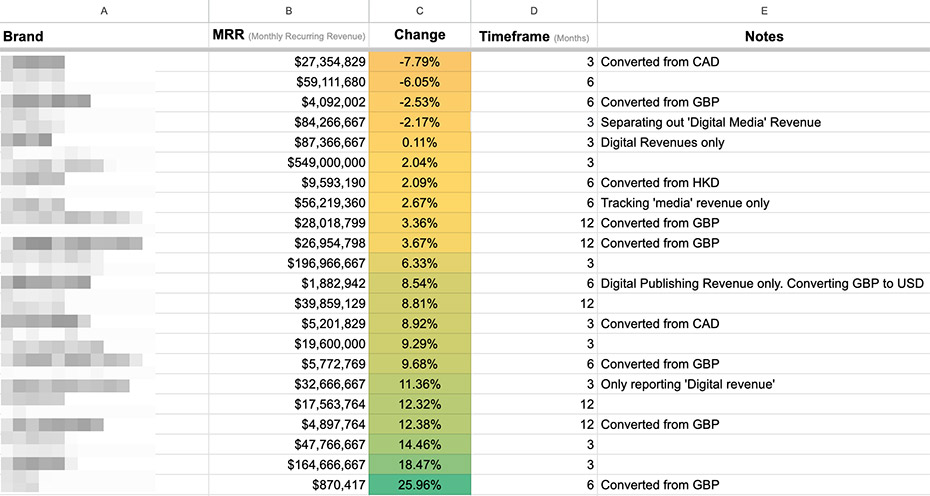
Before I reveal the top ten, please note they’re not 100% comparable as some separate digital media revenues and some don’t. It’s also not typical, and perhaps crude, to report their quarterly earnings divided by three as “monthly recurring revenue”.
I simply thought this helps put into perspective those that report quarterly earnings with those that report them annually but don’t expect to see them used in this way elsewhere.
With that clarified, here’s a sense of how big some of these companies are:
- Future Plc: $56.2M MRR (Example site:
 Tom’s Guide)
Tom’s Guide) - Reach Plc: $59.1M MRR (Example site:
 The Mirror)
The Mirror) - The Times Group: $74.2M MRR (Example site:
 Times Now)
Times Now) - Gannett: $87.8M MRR (Example site:
 USAToday)
USAToday) - Ziff Davis: $113.6M MRR (Example site:
 IGN)
IGN) - Dotdash Meredith: $139.1M MRR (Example site:
 Investopedia)
Investopedia) - Tripadvisor: $164.6M MRR (Example site:
 Tripadvisor)
Tripadvisor) - News Corp: $182.6M MRR (Example site:
 Wall Street Journal)
Wall Street Journal) - The New York Times Company: $199.4M MRR (Example site:
 The New York Times)
The New York Times) - Thomson Reuters: $531.3M MRR (Example site:
 Reuters)
Reuters)
Reach, Future and Ziff Davis’s revenues were converted from GBP to USD.
For Future Plc, Reach Plc, Gannett, Dotdash Meredith and News Corp I identified the most relevant part of their earnings, so for Ziff Davis I used ‘Digital Media’ revenue and for News Corp I used ‘News Media’ revenue. Sadly this wasn’t possible for every brand, and I will make this very clear when there’s a dedicated page on Detailed tracking these.
Finally, keep in mind this is simply how much money the companies are generating. Revenue is not profit.
TechTarget – All in On Their Content Strategy – Saw Search Traffic Grow 20% This Year
TechTarget is one of my favourite brands to follow because they’re in an industry where article recommendations can result in 7 and 8-figure deals; a space that “niche site builders” don’t tend to get involved in.
It should be the case that Google rewards true experts on the topics they cover, such as Application Development, Cloud Infrastructure and Big Data.
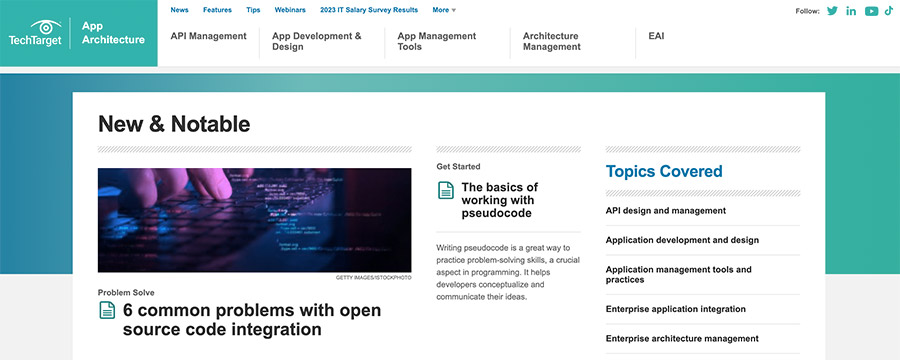
It’s a huge niche with a lot of money changing hands but as I say, not one your average blogger or niche site builder typically considers launching a brand in.
Still, SEO is important to their success and based on a recent earnings call, they’re seeing great results for some specific terms they track.
Our efforts have been rewarded by Google’s organic search algorithms. Organic traffic grew by over 20% in the quarter and, bear in mind, that is on top of 50% growth a year ago. The number of our articles that showed up as one of the top 3 results on Google was up 25% in the third quarter. Our focus on helping our visitors assess the latest technology trends in their businesses continues to pay off as we rank number one on over 1,000 AI-related terms, including the top 1 or 2 ranking for the search term “generative AI.”
More good news on this front: Google recently released a Core Update and a Helpful Content Update and we saw our rankings and traffic increase from both.
They’re still looking for revenue growth, however, reporting Q3 2023 revenue of $57.1M — a decrease of 26% compared to the same quarter last year.
TechTarget primarily publishes content on subfolders of their primary domain, such as https://www.techtarget.com/iotagenda/, but they also run sites like DataScienceCentral, TheServerSide and ComputerWeekly on separate domains.
Online Travel Magazine Atlas Obscura Is On Track to Generate $24M This Year With Their First Ever Profitable Quarter
Atlas Obscura dubs itself as the “definitive guide to the world’s hidden wonders” and has built a reputation over the past 14 years for doing just that.

I’ve always assumed the people behind the site were pretty secretive about their numbers, but it turns out they do share them now and then. Thanks to insights from both Digiday and Adweek (paywall) we can see how revenue has been going each year.
- 2021 revenue: $8M
- 2022 revenue: $18M
- 2023 revenue: $24M (expected)
If Wikipedia numbers are up to **** they’ve raised $9.5M so far.
While the website looks like a carefully designed travel blog at first glance, they’ve made forays into books, TV, podcasts and a trip-planning business that’s profitable in its own right.
In fact, the only thing that wasn’t profitable is the digital publishing business most of us will know them for.
That looks like it has changed now, posting their first-ever profitable quarter this year.
If Ahrefs estimates are accurate then they’ve grown search traffic 60% year to ****, with one of the most consistent rising charts I’ve seen in a while.
Similarweb suggests search traffic drives more than half of their monthly visitors, so it’s certainly an important channel for them.
The “Nerdwallet of Asia” Sees Revenue Grow 27% to $29M
One of my favourite things to do when researching how to stand out in a niche is to look at how brands in other countries operate.
If you’re trying to make a name for yourself in an industry and need some inspiration, consider looking beyond prominent success stories in the US and UK (the likes of Nerdwallet and MoneySavingExpert, in this case) but expand your horizons to the rest of Europe, Asia and Africa as well.
That’s partly why I wanted to share the numbers of MoneySmart, who generated $40M Singapore Dollars (~$29M USD) in 2022—growing revenue 27% year over year.
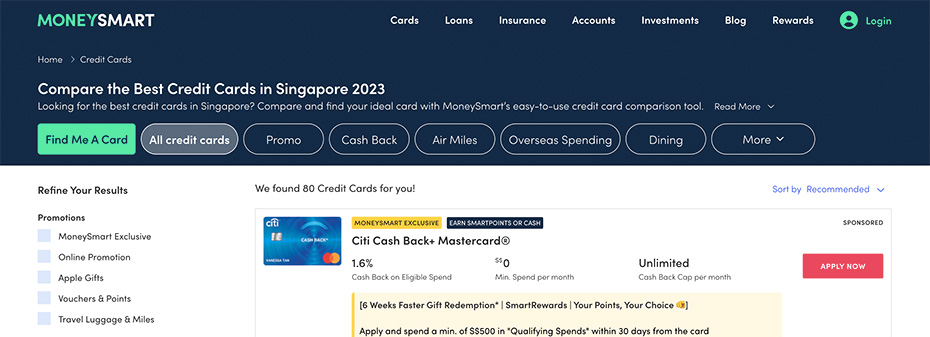
MoneySmart (.sg link) comprises of four individual websites:
- MoneySmart.sg 🇸🇬
- MoneySmart.hk 🇭🇰
- MoneySmart.tw 🇹🇼
- MoneySmart.ph 🇵🇭
The sites targeting Singapore and The Philippines are in English, while those targeting Taiwan and Hong Kong are written in Chinese.
They’re also behind their own insurance product, Bubblegum, which exclusively targets the Singaporean market.
If you’re familiar with Moneysupermarket, Nerdwallet, ValuePenguin and other similar brands, you won’t feel out of place on the homepage of their MoneySmart Singapore brand:
They’re a great example of how the same concept can work worldwide, and reports suggest an IPO might be on the horizon soon.
Indy100 Has Grown Traffic 211%, Writing Every Headline Its Owner Couldn’t
The way content is written on the news and politics site Indy100 definitely skews towards a younger audience.
Along with general world news and politics, you’ll find insights on what YouTubers and TikTok stars are up to and what’s trending on social media.
It’s not particularly out of place in the broader internet, but they don’t write the kind of headlines you would find on their parent site, the UK’s The Independent.
Launched in 2014, the site was initially called i100, with the aim to take serious, fact-checked articles and package them in a more social-friendly format, allowing people to ‘vote’ on their favourite articles.
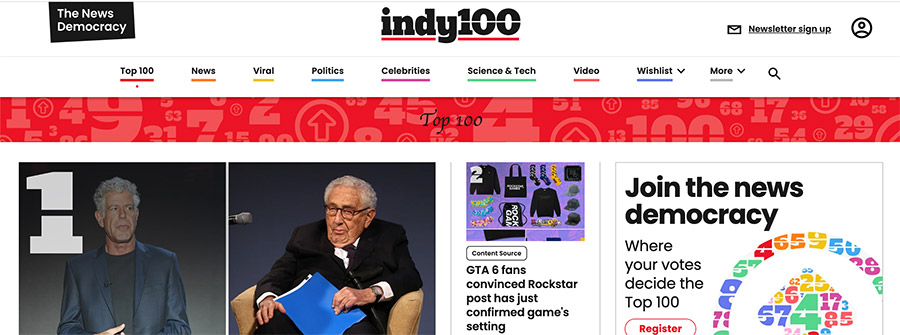
Almost a decade later, efforts are paying off, with traffic having grown 211% year over year, reaching 3.3M readers.
If the success continues, and I can’t see why it couldn’t at a time when people are looking for the next quick story to talk about, other large media brands might follow suit.
eCommerce SEO Freddie Chatt Takes His Cricket Bat Store to $12,000/m with Organic Search Traffic
One of the more interesting case studies I came across recently was from Freddie Chatt, who revealed how important SEO was to help grow his Cricket Bat eCommerce store past £10,000 (~$12,000) in monthly revenue.
Freddie was more open than most, sharing the site recently surpassed 1,500 daily clicks from Google, and even went into his process for picking search terms to target.

Freddie has very kindly said nice things on Twitter about our training program, SEO Blueprint, but obviously I claim no part in his success and he has no idea I’m even mentioning him here.
I want to be on the ball with everything interesting that’s happening in the world of SEO, and his story and the depth he went into in the case study fit that criteria.
Guitar.com Gets A Redesign (And Some Creative New Content Angles)
August saw the announcement that NME Networks (owned by Caldecott Music Group) had completely revamped the design of its flagship site, Guitar.com.
I don’t think the new design will be for everyone, but I appreciate that they’ve tried to do something different.

Their first interesting content addition was that they now feature news about the business side of the Guitar industry (pictured above). I don’t know how much interest there will be from people just looking for Guitar recommendations, but niche news can be very well received.
They’re also highlighting jobs in the industry, which might serve as a smart way to grow their relationships with the respective brands they’re reviewing the products of.

On top of that, they also launched two dedicated new video sections of the website: 60 seconds, which gives a one-minute look at products in the space and GuitarShopping, where they look at what’s on offer in Guitar stores worldwide.
Honestly, I’m impressed. This is the exact kind of content and focus anyone trying to make a name for themselves in the space should be publishing.
That said, there are no guarantees that their investments will pay off or that they’ll be able to sustain the updates for the long term.
Still, I massively admire that they’re giving it a go.
Goliath can still be creative.
Local Media Brand Narcity Average 12M Unique Visitors Each Month. Here’s Their Plan After Facebook Blocks Canadian News
It’s something you never want to think about: An important platform for reaching your desired audience, completely blocking anything you have to share.
Yet, that’s exactly what happened in Canada in recent months, with Facebook moving to block news sites from the country. Specifically, Facebook’s changes stated,
News links and content posted by news publishers and broadcasters in Canada will no longer be viewable by people in Canada. We are identifying news outlets based on legislative definitions and guidance from the Online News Act.
Narcity Media Group were one company impacted and is now planning different promotion strategies. According to their homepage, their current numbers are:
- 12.3M average unique monthly visitors
- 26.4M monthly pageviews
- 300M ad impressions per month
I understand that most of this traffic goes to their Narcity.com website, though they’re also behind MTL Blog, which focuses on the city of Montreal.

In their blog post highlighting their plans, they said (paraphrasing):
- They aren’t waiting around and will look to make their mark on other platforms
- They’re diving deeper into TikTok, Google Ads, YouTube, Twitter and Threads (where they’re surprisingly not blocked)
- They’re improving their video strategy to “ensure they hit the mark every single time”
If Similarweb estimates are accurate, Facebook traffic only makes up around 0.20% of their monthly visitors. Of course, their on-platform reach was important, with their Narcity Canada page boasting 1.3M followers.
SEO is estimated to be their most significant marketing channel by far.
Australia’s #1 Digital News Brand Gets In On The Product Reviews Game
One of the nice things about reviewing products with a non-US focus is that you tend to have much less competition in search results. The downside is that there’s generally far less traffic potential as well.
Australian niche site owners now have one more site to compete with however, as the country’s biggest news site, News.com.au, has launched its product review section, ‘Checkout‘.

I have to respect that they haven’t gone for the same generic headlines as every other news brand that follows this route and have at least tried to put their own spin on things.
Current examples on the homepage include:
- $40 non-stick frying pan that makes cooking ‘so easy’
- Air fryer that’s ‘best kitchen appliance ever’
- $35 ‘glowy’ beauty buy shoppers swear by
In other words, they’re writing for people who are already on their site as well as search engines, and with a domain as authoritative as theirs, I imagine they’ll start to rank quickly.
There were a lot of statements you would expect from the launch, like they’re now “helping Australians make informed choices”, but one sentence stood out:
Six in 10 online shoppers (62 per cent) have increased the time they spend shopping around and researching since the recent rises in living costs.
Logically, this makes sense, and it’s notable to see research back it up.
I thought it was notable to add that they said they’ve also seen this product-review approach work for other brands, like the New York Times with Wirecutter, Buyside from WSJ (which we covered in Q1) and CNN Underscored.
Ziff Davis Appear to Be Positive on the Future of AI and Search Traffic, But Bustle Digital Group, Not So Much
Ziff Davis’s Q3 2023 earnings report saw them share some interesting data on the click-through rates they’re seeing for their top content.
As a quick back story, Ziff Davis is behind some well-known content brands like PC Mag, IGN & Ask Men, and they also own popular SEO SaaS platform, Moz.

Their announcement mentioned that they sampled keywords across sites responsible for most of their search traffic, and then checked to see if they resulted in an AI-generated response.
23% of their most valuable keywords prompted a response from Google’s Search Generative Experience (SGE) and 20% resulted in an AI response from Bing.
They added that on Bing, AI-generated responses had a higher click-through rate than those without.
They said they couldn’t measure click-through rates in Google SGE but expected a similar outcome from what they saw with Bing.
Going back to Moz, they added, “Our SEO experts at Moz share similar views based on their experience and expertise in the space.”
Sadly we don’t know how many keywords they looked at and across how many sites, but to have people at Moz back it up makes me think the numbers must have been pretty significant.
Of course, we can’t discount that they would like to say positive things about the future of SEO when on an earnings call with investors.
On the other side of the coin, Bustle Digital Group’s CRO Jason Wagenheim revealed to Brian Morrissy some less positive thoughts on the topic.
In short order, and by that I mean the next one to three years, you will be searching for something and you will get a definitive single article that has stolen and culled information from thousands of sources, including ours, and you won’t have to go to Bustle.com and get an ad impression delivered to you in a view. It is going to be very disruptive.
I currently track 11 sites for Bustle Digital Group, such as Bustle.com, Fatherly, Elite Daily, Inverse and Mic.
AI and how it might impact my career and this industry I **** so much was my primary motivator for starting to take my tracking of digital goliaths more seriously, and I **** that companies are frequently sharing their thoughts.
FLYING Mag Group Reach 3M Monthly Visitors and Continue Their Impressive Acquisition Spree
Over the last few years, Flying Mag Group have purchased dozens of aviation brands to grow massive market share in their space.
Things ramped up when Craig Fuller, founder and CEO of FrieghtWaves, acquired FLYING from Bonnier.
In August, they announced the acquisition of AirlineGeeks and their plans to turn it into a “premier business-to-business data, news and market intelligence platform for the commercial aviation industry.”

They’re covering a niche market, but it’s a market with an incredibly wealthy audience.
In October they announced the acquisition of AVBuyer, a physical magazine and website that is primarily a marketplace for buying and selling aircraft.
Just a few weeks later they announced the acquisition of marine media brands from Bonnier, such as Boating, Yachting, Sailing World, Cruising World and many more.
While it’s not a space I have an interest in myself, it was fascinating to read some of the market stats they’ve shared in their updates:
- In the US alone there are 3.5 million annual sailing participants
- More than 59,000 yachts are purchased annually (900+ of which are described as ‘super yachts’)
- There are more than 25 million recreational boats in the US
- More than 55 million Americans participate annually in recreational fishing
- They believe the global market size for the airline industry to be over $840Bn, and it’s growing
Finally, in one of their updates Flying Media Group announced an audience of nearly 3 million monthly visitors and subscribers, which they state is “unmatched by any other aviation media source.”
Attracting An Estimated 97M Monthly Visits, Freepik Continues to Take Over The Design Niche Online
Freepik isn’t the typical company I anticipated talking about in these reports, mainly because they dominate Google with images rather than articles.
That said, they’re undoubtedly a Digital Goliath in their niche, with Ahrefs estimating Google sends their main site over 50 million clicks each month.
The first piece of news over the last quarter is that they rebranded, going from a fairly standard logo style to one which emits the vibe of a design company.
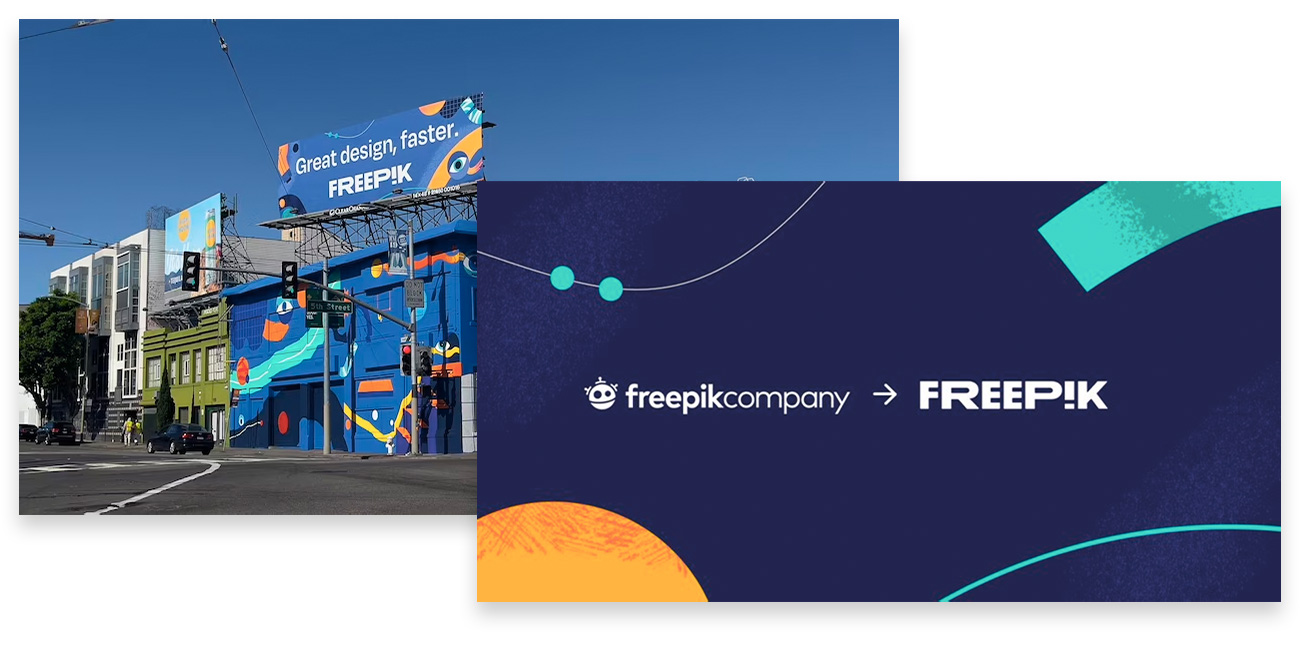
They also announced the acquisition of Berlin-based stock photography brand EyeEm, which boasts a catalogue of over 160 million photographs.
Other sites we track for them include:
- Flaticon, a resource with over 12M vector icons and stickers
- SlidesGo, for PowerPoint and Google slides templates
- Wepik, an online design editor similar to Canva
I **** companies that are dominating their space but at the same time kind of under the radar for how well they take over search results.
Luxury eCommerce Store 1stDibs Continue to See International Search Traffic Grow
I covered in Q1 how eCommerce store 1stDibs were seeing success when attempting to expand their reach in Germany and France.
International search traffic growth has continued in those countries and more. Sharing two separate comments on their earnings call, they said:
Moving on, we continue to see solid organic traffic growth in France and Germany. SEO sessions from German and French IP addresses grew 60%. Paid traffic growth in these markets declined as we intentionally pulled back on performance marketing, which was a headwind to order growth.
However, conversion rates improved. We also saw organic traffic growth accelerate for Italian and Spanish IP addresses as our sites are starting to be indexed by search engines, but it remains very early days in these markets. [..] Our marketplace unit economics continue to improve, driven by expanding gross margins, and increasing advertising efficiencies, partly driven by the strong growth in our SEO traffic. We reduced our cost to acquire a net new active buyer by 27% year-over-year.
Some eCommerce brands go the country-specific domain route, but 1stDibs have built sections of their site on /it/, /de/, /es/ and /fr/ subfolders.
Thanks to Ahrefs we can see their Spanish-language section has gone from 0 to almost 50,000 pages in just a few months:
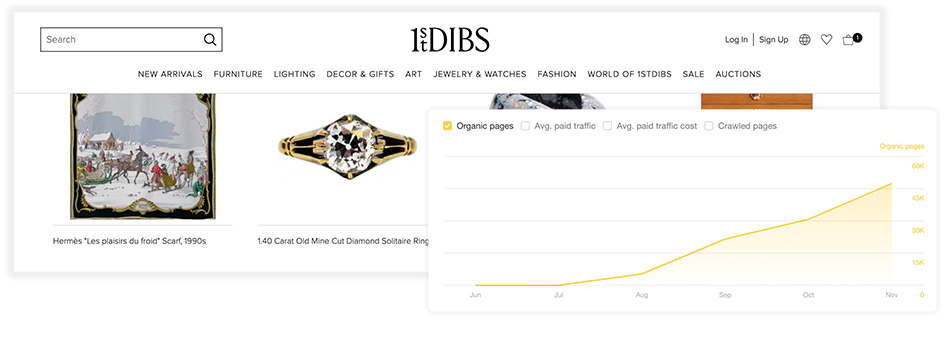
They continue to be a great case study for other eCommerce brands wanting to expand their reach to different countries.
I No Longer Track Homepage Title Tag Changes, So Here’s What We’ll Miss
After more than a year of tracking, I recently decided to stop monitoring title tag updates of popular sites.
I started out of curiosity and found many of them to be funny or just plain odd, but there was too much noise in the updates that made me feel like I was wasting my time browsing them.
I may change course on that in the future, but I thought it would be nice to give you an idea of what big sites do to their title tags.
| Before | Maryland Daily Record | Maryland Daily Record |
| After | Maryland Daily Record – Maryland Daily Record |
| To pipe or dash. That is the question. | |
| Before | Reader’s Digest: Online Magazine, Competitions and More |
| After | Readers Digest |
| Someone at RD decided to keep things simple | |
| Before | I Waste So Much Time |
| After | Funny Memes, Dank Memes, Best Memes – I Waste So Much Time |
| While someone at IWSMT decided to put some keywords upfront | |
| Before | TechRadar | The source for tech buying advice |
| After | TechRadar | the technology experts |
| Your guess on the reasoning of this is as good as mine | |
| Before | Coverage.com – Just another WordPress site |
| After | Coverage.com |
| You can head to Settings > General in WP Admin if your own title tag looks similar | |
| Before | Vimeo – Video Experience Platform |
| After | Vimeo Interactive Video Experience Platform |
| I can’t help but wonder how discussions go when big companies decide on changes like this | |
| Before | DigitalOcean | The Cloud for Builders |
| After | DigitalOcean | Cloud Hosting for Builders |
| Another case where I wonder how many people had to approve this | |
| Before | Latest World & National News & Headlines – USATODAY.com |
| After | USA TODAY – Breaking News and Latest News Today |
| “Let’s put the brand name upfront, it’s cleaner”. | |
The added commentary was just for fun since I always wonder how these discussions go behind the scenes.
Three Independent Niche Websites Found Themselves with New Owners (One Of Which I’ve Covered Here Multiple Times)
In my guide to the top ranking sites in 10,000 affiliate search results, modern home brand resource Living Cozy was highlighted as one of the top independently owned sites I found.
You may recognise founder Ash Read as Buffer’s previous head of content, who created the site after struggling to find furniture online to match his tastes.
Now, Living Cozy has been acquired.

I have a feeling Ash would tell me who is now behind the site if I asked (and he was allowed), but I’ll wait to see who the new owner is like everyone else when they update their footer copyright and privacy policy.
During his ownership the site:
- Generated 4.5 million pageviews
- Over 900,000 referrals were sent to partners
- Achieved more than $12M in revenue generated for partners
I consider Ash a friend, so I’m thrilled to see him get an end result after building such a great resource over the years.
Another person I consider a friend, as far as talking to each other on the internet goes, is Shawn Hill.
Shawn has several accolades I could put next to his name, but I can no longer call him The Grilling Dad in title case.
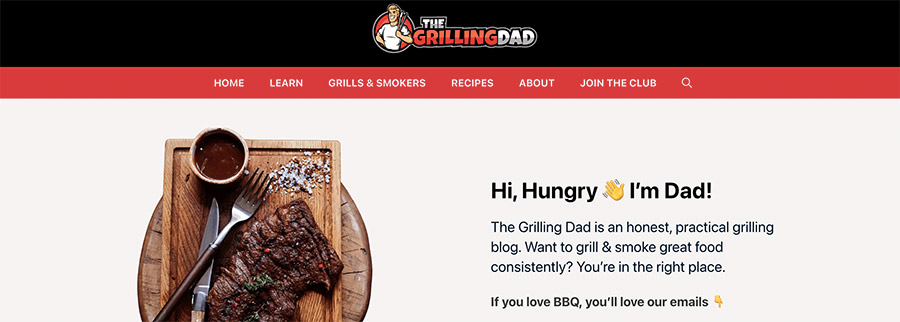
In August he announced the sale of his BBQ-focused site by the same name, which at one point generated over $25,000 per month.
The third acquisition is one where I have zero connection to the owner, but I still wanted to highlight it here.
Hollywood and celebrity gossip site Hollywood Life, estimated to reach millions each month, was acquired by Factz Media Company.
You’re probably yet to hear of Factz since it only launched in 2022, but they’re said to have more acquisitions planned, so I doubt this will be the last quarterly report I mention them in.
BONUS: What I’m Working on For the Rest of 2023 (And the Tweet That Went Crazy)
Search results are as turbulent as I’ve ever seen them, primarily driven by multiple overlapping Google updates and a (likely) constant battle for Google to keep up with AI-generated content.
I know many people are concerned about the future of SEO and their success with this traffic source, which is precisely why, 18 months ago, I started tracking the rankings and revenue of digital goliaths so closely.
If people continue to read, share and enjoy these updates, I’ll keep documenting insights each quarter to the best of my ability.
For the rest of the year, my primary focus is going to be adding updates to SEO Blueprint as we embark on launching the third version of the program, creatively named SEO Blueprint 3. 😬
(This is the personal section of the report; I can use emojis now).
It initially launched in 2019, with the introduction of SEO Blueprint 2 Superpixels in 2021.
SEO Blueprint 2 built on our technical, link building and keyword research foundations to show precisely how to build an authentic brand in your space and stand out with creative ideas to give you a chance against digital goliaths.
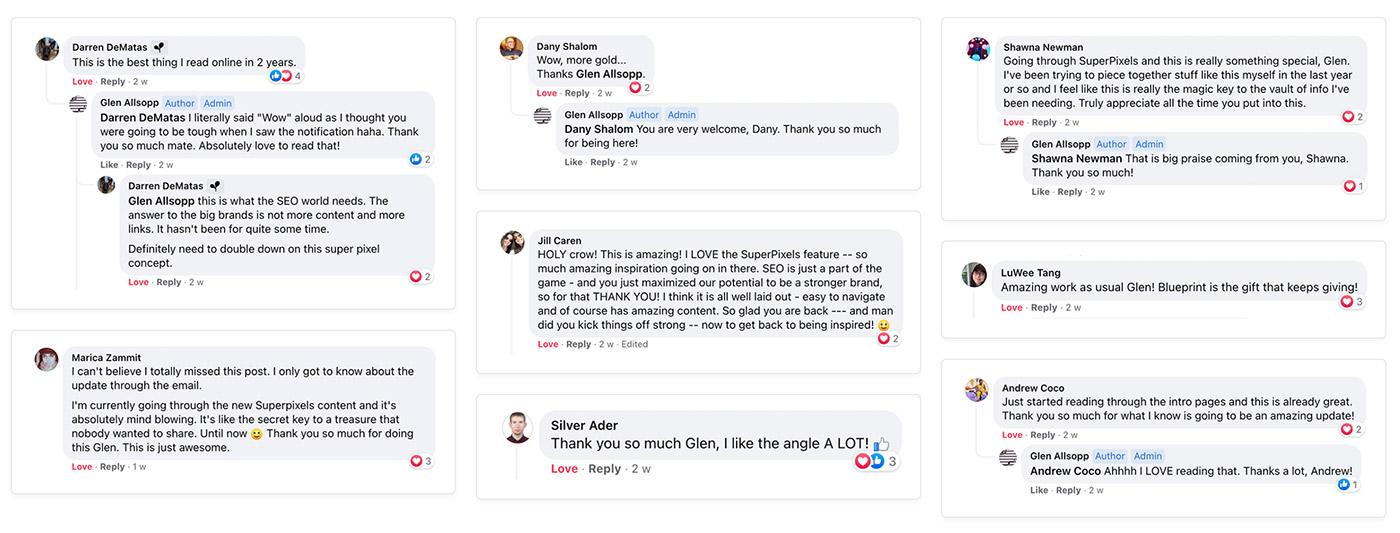
Two years and two months later, that concept is as important as ever, and the vast majority of ideas I shared are still (fortunately) a rarity on the web.
SEO Blueprint 3 (waiting list link) – free for all current members – is going to take all of the evergreen insights I’ve learned from studying Digital Goliaths and give more actionable tactics on how you can stand out in any industry.
The aim is for anyone following the insights to be a few years ahead of what will be required going forward.
I plan to launch the course at some point in Q1 2024. If you’re interested, you can join the waiting list here.
As I promised to members who trusted us from day one, I would never decrease the price of the course so we didn’t do any Black Friday or Cyber Monday deals. If you’re interested, the waiting list is how you’ll join us for the best price.
Finally, I was going to share a very small offer ($40) that I wanted to work on during my writing breaks in December but Joe Davies from FATJOE kindly tweeted about it a few days ago and now the waiting list is huge. It went from 3 days to 14 days overnight.
I’m honoured and appreciative to have a waiting list for anything I do, but I also don’t like making people wait so long for something.
There’s a link to that somewhere on this website but I can’t promote it directly due to the queue so that’s all I’ll say.
If you’ve enjoyed reading this update, please let me know. I put weeks of work into finding and curating the best ideas to share with you and try to write them up in an easy-to-follow way.
You can discuss this post on Twitter, Facebook and LinkedIn, where I would sincerely appreciate any shares. I notice them all.
Thank you, as always, for reading.
– G
P.S. If you have your speakers turned on, click the little emoji ‘Like’ button below for some cheesy fun 🙂
